 Construction workers restoring a 19th century mansion that once belonged to the noble Naryshkin family discovered an immense treasure of silver services, pearl- and porcelain-handled flatware, enamel, jewels, and medals, hidden in a secret storage compartment between the second and third floors of the building. More than 1,000 individual pieces from the 19th and early 20th centuries were found, all of them in excellent condition thanks to careful packing in vinegar-soaked cloths.
Construction workers restoring a 19th century mansion that once belonged to the noble Naryshkin family discovered an immense treasure of silver services, pearl- and porcelain-handled flatware, enamel, jewels, and medals, hidden in a secret storage compartment between the second and third floors of the building. More than 1,000 individual pieces from the 19th and early 20th centuries were found, all of them in excellent condition thanks to careful packing in vinegar-soaked cloths.
 The objects were then wrapped in newspapers from March, June and September of 1917, which gives us a handy time frame for when the treasure might have been buried. This was a turbulent time in Russia, to say the least. The Duma had taken control in February, setting up the Russian Provisional Government and forcing Tsar Nicholas II to abdicate. Some months later the October Revolution would bring the Bolsheviks to power. Within days, Lenin’s Decree on Land abolishing private property was passed by the Second Congress of Soviets. The first floor of the mansion was put to use as a stolovaya, a cafeteria-style restaurant where workers could get a cheap meal.
The objects were then wrapped in newspapers from March, June and September of 1917, which gives us a handy time frame for when the treasure might have been buried. This was a turbulent time in Russia, to say the least. The Duma had taken control in February, setting up the Russian Provisional Government and forcing Tsar Nicholas II to abdicate. Some months later the October Revolution would bring the Bolsheviks to power. Within days, Lenin’s Decree on Land abolishing private property was passed by the Second Congress of Soviets. The first floor of the mansion was put to use as a stolovaya, a cafeteria-style restaurant where workers could get a cheap meal.
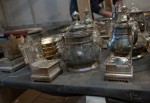 The Naryshkin family, whose many illustrious members include Nataliya Naryshkina, wife of Tsar Alexis and mother of Peter the Great, and Princess Maria Naryshkina, mistress of Tsar Alexander I, fled the country in 1917 leaving behind a wealth of riches that were moved to the State Hermitage Museum in 1920. Several of the silver sets found in the mansion bear the family crest. The treasure might not all have belonged to the Naryshkins.
The Naryshkin family, whose many illustrious members include Nataliya Naryshkina, wife of Tsar Alexis and mother of Peter the Great, and Princess Maria Naryshkina, mistress of Tsar Alexander I, fled the country in 1917 leaving behind a wealth of riches that were moved to the State Hermitage Museum in 1920. Several of the silver sets found in the mansion bear the family crest. The treasure might not all have belonged to the Naryshkins. 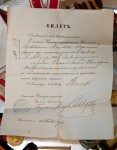 Documents belonging to army officer Sergei Somov were also found among the objects, so perhaps some of it was once his. Somov also fled the country after the October Revolution. He died in France in 1976.
Documents belonging to army officer Sergei Somov were also found among the objects, so perhaps some of it was once his. Somov also fled the country after the October Revolution. He died in France in 1976.
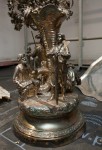 The mansion is itself a historical treasure, despite the hard treatment it has received. It used to be two separate buildings, one of them built in the 17th century by Prince Pyotr Trubetskoi, the other owned in the 18th century by Abram Petrovich Gannibal, the African great-grandfather of poet Alexander Pushkin who as a child had gone from being a hostage of the Ottoman Sultan to the godson of Peter the Great who had him raised and educated along with his own children. In 1832 the two houses were made into one large mansion which Duke Vasily Naryshkin bought in 1875.
The mansion is itself a historical treasure, despite the hard treatment it has received. It used to be two separate buildings, one of them built in the 17th century by Prince Pyotr Trubetskoi, the other owned in the 18th century by Abram Petrovich Gannibal, the African great-grandfather of poet Alexander Pushkin who as a child had gone from being a hostage of the Ottoman Sultan to the godson of Peter the Great who had him raised and educated along with his own children. In 1832 the two houses were made into one large mansion which Duke Vasily Naryshkin bought in 1875.
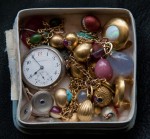 After the fall of the Soviet Union, the Trubetskoi-Naryshkin mansion was converted into apartments. In 1999, the St. Petersburg International Center for Preservation set up offices in the historical building. Ten years later, construction company Intarsia began a three-year program of re-engineering, restoring and adapting the building for use as a restaurant (doubtless a pricier one this time) and a conference and cultural center.
After the fall of the Soviet Union, the Trubetskoi-Naryshkin mansion was converted into apartments. In 1999, the St. Petersburg International Center for Preservation set up offices in the historical building. Ten years later, construction company Intarsia began a three-year program of re-engineering, restoring and adapting the building for use as a restaurant (doubtless a pricier one this time) and a conference and cultural center.
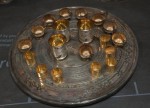 Intarsia reported the discovery to the police on Thursday, March 29, but it appears some pieces were discovered by workers a few days before that. Police searched the site and discovered two caches, one containing three gilded silver salvers, the other a box of silver forks and spoons, which had been secreted behind construction debris. Some workers apparently hoped to smuggle them out when the coast was clear.
Intarsia reported the discovery to the police on Thursday, March 29, but it appears some pieces were discovered by workers a few days before that. Police searched the site and discovered two caches, one containing three gilded silver salvers, the other a box of silver forks and spoons, which had been secreted behind construction debris. Some workers apparently hoped to smuggle them out when the coast was clear.
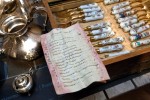 A full inventory and assessment of the treasure by St. Petersburg’s Committee for the State Control, Use and Protection of Historical and Cultural Monuments (KGIOP) is ongoing. When they’re done, the treasure will be put in a museum. Intarsia hopes they’ll be able to put it on display in the second floor exhibition rooms of the Trubetskoi-Naryshkin mansion once the restoration is done later this year.
A full inventory and assessment of the treasure by St. Petersburg’s Committee for the State Control, Use and Protection of Historical and Cultural Monuments (KGIOP) is ongoing. When they’re done, the treasure will be put in a museum. Intarsia hopes they’ll be able to put it on display in the second floor exhibition rooms of the Trubetskoi-Naryshkin mansion once the restoration is done later this year.
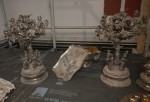 The question of ownership might get thorny, though. By law, the workers who discovered the treasure can claim 50% of it and the property owner the other half, unless it is deemed of historical or cultural value, which in this case seems a foregone conclusion. If the treasure is deemed historically significant, the state will claim ownership and reimburse the finders/owners the market value.
The question of ownership might get thorny, though. By law, the workers who discovered the treasure can claim 50% of it and the property owner the other half, unless it is deemed of historical or cultural value, which in this case seems a foregone conclusion. If the treasure is deemed historically significant, the state will claim ownership and reimburse the finders/owners the market value.
Then there are the family members. Any Naryshkin descendants who might be out there could make a claim, as could any Somov descendants.
Ivan Artsishevsky, chairman of the House of Romanov, said the discovery of the treasure could cause self-proclaimed Naryshkin descendants to step forward, demanding the treasure be returned to them.
“In my experience of working with the Romanovs, I can say that ‘secret’ descendants from the Emperor’s dynasty regularly appeal to me with all kinds of claims and demands. In this case many such ‘relatives’ may appear,” Artsishevsky was quoted as saying by Interfax.
Artsishevsky said all of the precious objects found should be donated to a museum, adding that he was sure that no real Naryshkin descendants would come forward in hopes of claiming the treasure.
“All this should be given to a museum. All of these objects actually belong not to the Naryshkins, but to all Russian people. I doubt any of the duke’s descendants would believe otherwise,” he said.
Perhaps the museum could put all of these treasures on display in an exhibit called, “No wonder we had a revolution.”
😆 That’s what the Winter Palace is for.
I am very pleased that the St Petersburg International Centre for Preservation set up offices here in in 1999. And I am very pleased that the treasures will go into museums.
But you ask the right question yourself i.e are there any Naryshkin (or even Somov descendants) who might be out there to make a claim? The history of rightful descendants winning court cases on their European grandparents’ treasures has not made for happy reading.
There are all kinds of potential entanglements. I read that a Communist Party official also believes his group has a claim to the treasure, because they’re the political heirs of the party that nationalized private property.
No Naryshkin ever had the title of Duke, it is not a title in the Russian nobility (with the exception of Grand Duke and Grand Duchess who are children of the Tzar or Tzarina. The illegitimate children of Tzar Alexander I and his mistress Maria Antonovna Naryshkina (Russian: Мария Антоновна Нарышкина, 1779–1854), born Princess Maria Antonovna Svyatopolk-Chetvertinskaya, kept the name Naryshkin and received the titles of Prince and Princess, but they had no descendants. They are the only people bearing the name Naryshkin (but not of the Naryshkin family) who had those titles. In fact, the Naryshkin family has at all times refused to have titles, with the exception of two of them who accepted the title of count. Indeed, the family’s chief ancestor used to say that “The Tzar can make all the Princes, Counts and Barons he wishes, but he can never make a Naryshkin”. Prince, Count and Baron were the only titles in the Russian nobility.
The Naryshkin family stems from the ancient nobility — which the descendants of Rurik and Gediminas and boyars inherited: e.g., the Shuyskies, Galitzins, Naryshkins, Khilkoffs, Gorchakovs, Belosselsky-Belozerskys and Chelyadnins. The Naryshkins are descended of an ancient Tatar Boyar family.
There is in fact a possibility that the few remaining authentic Naryshkins (living in the USA, in South Africa and in Europe) may obtain half of the treasure or half of its value in compensation.
There are several Naryshkin’s living in Europe, mostly in Paris, London, Rome and in Geneva. In Argentina there is a Princess Dietrichstein whose grandmother Olga Aleksandrovna Dolgoruky was a daughter of Princess Olga Lvovna Naryshkina, she is a descedent of a sister of Prince Lev Narishkin, but I am sure that she knows who are the surviving cousins, who are the owners of the objects, jewles and artifacts found in Saint Petersburg
I agree with kniaginia princess Vera Narishkina, the title translated to English, French, Spanish is Prince, Prince, príncipe, only in German you have to say Gross Herzog nicht Gross Prinz or Fürst. But I have to disagree with this Russian gentleman, all the objects belong to the Narishkin family not to the Russian people, the illegal confiscation of properites in Russia should be compensated as soon as possible. I did have lots of Russian friends like Prince Dmitri Nikolaevich Volkonsky or the Princes Gortschakov (Mijail, Sergey, Sophia, etc), Orlov-Davydov, Dolgoruky and most of them, who still live, want some kind of compensation of what was ransacked by the Bolsheviks to them. Sergey Gortschakov spent a lot of time in Petersburg and at the end told me Putin is just another Bolshevik he will not return any property to us, on the contrary what is happening in Poland and the Czech Republic. My friend countess Tatisheva whose grandfather was murdered by the Reds, alongside with the Imperial family, wants that the Russian government should recognize her as a heiress of one of the victims of the Red terror, but knowing who are in charge in Moscow I doubt it.
I will be more pleased if the “treasure” will return to the rightfull owners the Naryshkin family, which lives abroad as most of the Russian nobilty, who survived the horrors of the Red genocide.
Actually, there is only one genuine Naryshkin living in the UK, she recently got married. There is only one living in Paris, she is extremely old and never got married. There are several genuine Naryshkins living in the USA – in Rhode Island, in Florida and in Missouri. As I said before, there never was any princes or princesses Naryshkin, the only ones who bore that title were the illegitimate children of zar Alexander I and his mistress Maria Antonovna Naryshkina (Russian: Мария Антоновна Нарышкина, 1779–1854), born Princess Maria Antonovna Svyatopolk-Chetvertinskaya, who kept the name Naryshkin and received the titles of Prince and Princess, but they had no descendants, nor had they a drop of Naryshkin blood.
I am not kniaginia or princess Naryshkina. Our family has always refused to have titles (with one or two exceptions who accepted the title of count). I forgot to mention that there is one other exception – an illegitimate son born to a Naryshkin wife, fathered by the then Furst of Liechtenstein. During or shortly after the Revolution, he fled to Liechtenstein and his natural father, the Furst of Liechtenstein, granted him asylum, the Liechtenstein nationality, and the title of prince – but there again, this prince Naryshkin was a Naryshkin in name only and not a member of the Naryshkin family, neither did he have a drop of Naryshkin blood.
Actually, some property has been “retured” (sold) to a branch of the princes Galitzine who have settled there, in Saint Petersburg.
I forgot to add the genuine Naryshkins who are living in South Africa.
I’m excited to find this article.
The army officer Sergei Somov was my grandfather. He passed away in 1976 but not in France. He lived in Florida when he passed away from cancer.
This is extraordinary. In Perth, Western Australia a line of the Somov (Somoff) family reside. My partner is Alexandra Aleksej Somov. She is the daughter of Aleksej Borisevich Somov (dec.). They are direct descendents of the Naryshkin family. My partner has in her possession all the family records to prove this genealogical link.